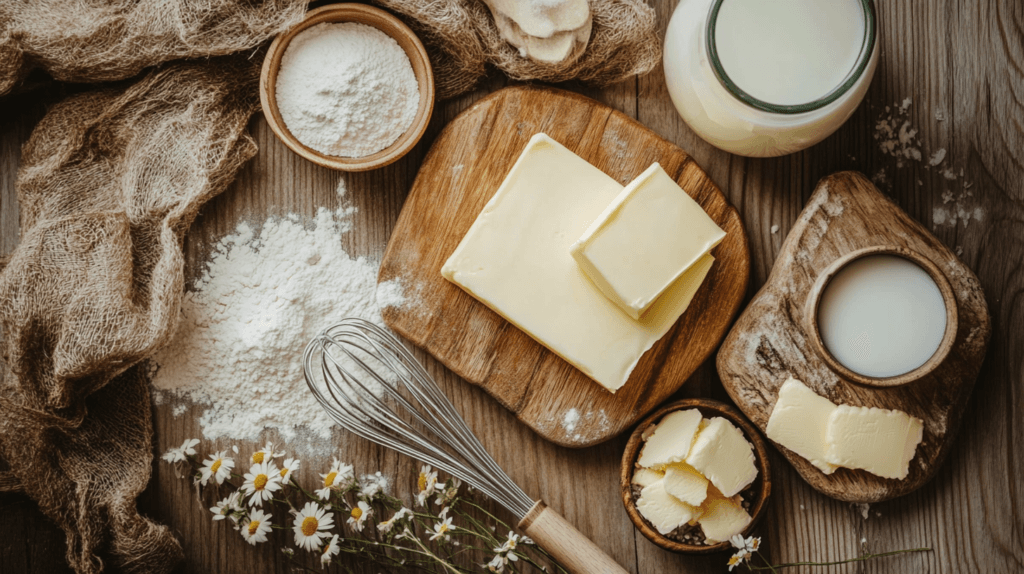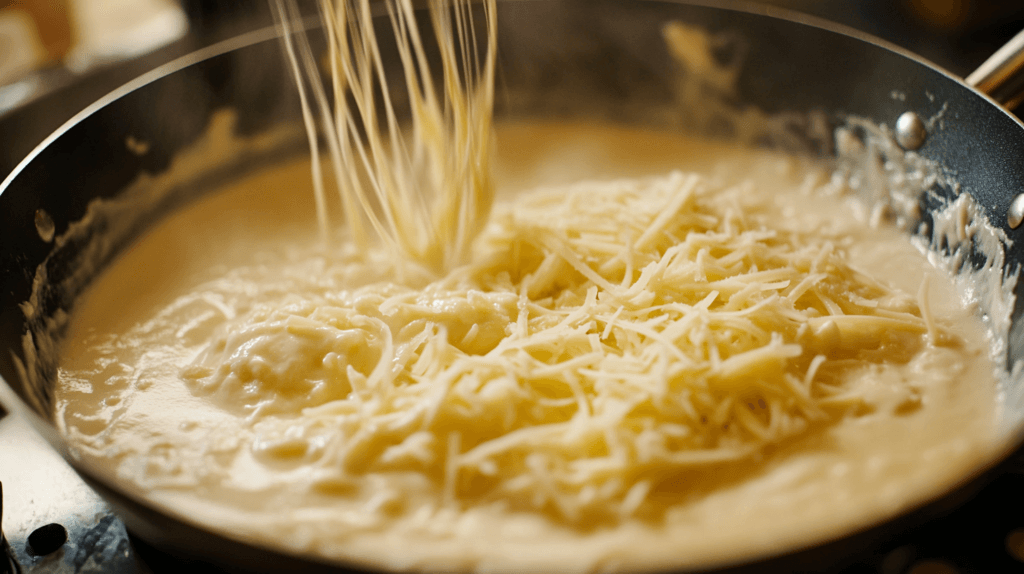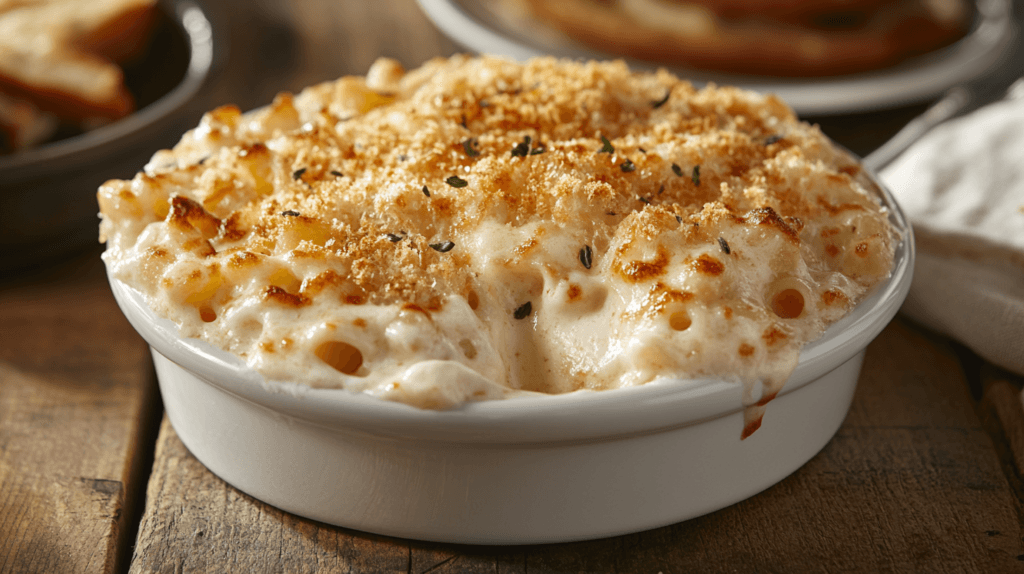How to make a roux for mac and cheese is an essential skill for creating the ultimate creamy, cheesy pasta dish. At the core of its luscious texture lies the roux, a simple yet vital cooking technique. But what exactly is a roux, and why is it so important for mac and cheese?
A roux is the secret to achieving a velvety, lump-free cheese sauce. Without it, your mac and cheese might end up watery, clumpy, or lacking the rich texture you love. In this guide, we’ll take you through the step-by-step process of making a roux, from selecting the right ingredients to achieving the perfect consistency. Whether you’re new to cooking or a seasoned home chef, this guide will help you master the art of the roux for the ultimate mac and cheese experience.
Table of Contents
What is a Roux for Mac and Cheese?
Definition of Roux
A roux (pronounced “roo”) is a combination of fat and flour cooked together to create a thickening agent. It’s the backbone of many classic dishes, from creamy soups to hearty stews and, most importantly, the base for a luxurious cheese sauce in mac and cheese.
History and Culinary Significance
Originating in French cuisine, the roux has been a staple in cooking for centuries. Chefs in France developed it as a way to add both flavor and texture to sauces, and it remains a cornerstone of culinary tradition worldwide. Today, it’s an indispensable technique for anyone who wants to elevate simple ingredients into gourmet dishes.
Role of Roux in Mac and Cheese
In mac and cheese, the roux is the secret behind the silky, creamy cheese sauce that clings to every bite of pasta. Without it, your sauce might separate or become too runny. The roux not only thickens the sauce but also ensures an even distribution of cheese and flavors, creating that perfect, melt-in-your-mouth experience.
Ingredients for a Perfect Roux for Mac and Cheese
Basic Ingredients for Roux
The beauty of a roux lies in its simplicity. You only need two ingredients:
- Fat: Butter is the most common choice for mac and cheese, thanks to its rich flavor and smooth texture. However, other fats like margarine or even olive oil can be used.
- Flour: All-purpose flour is ideal because it provides the right consistency without altering the flavor.
Optional Ingredients for Flavor Boosts
Want to add a little flair to your roux? Consider incorporating these optional ingredients:
- Seasonings: A pinch of garlic powder or onion powder can add depth to your cheese sauce.
- Spices: A dash of paprika or cayenne can bring a subtle kick.
- Aromatics: Finely minced shallots or onions sautéed in the butter before adding flour can infuse your roux with extra flavor.
Tools You Need to Make a Roux for Mac and Cheese
Essential Kitchen Equipment
Making a roux doesn’t require fancy tools, but having the right equipment can make the process smoother:
- Heavy-Bottomed Pan: A sturdy pan helps distribute heat evenly, preventing the roux from burning.
- Whisk or Wooden Spoon: A whisk is excellent for creating a smooth roux, while a wooden spoon is useful for stirring thicker mixtures.
- Measuring Cups and Spoons: Accurate measurements ensure the perfect balance of fat and flour.
Tips for Choosing the Right Pan
A wide, shallow pan works best for making a roux. It allows for even cooking and makes it easier to whisk the mixture without spilling. Non-stick pans are a great option for beginners, as they reduce the risk of the roux sticking or burning.
Step-by-Step Guide: How to Make a Roux for Mac and Cheese

The secret to a rich, creamy mac and cheese lies in mastering the roux. Here’s a detailed step-by-step guide to ensure you get it just right every time.
Step 1: Measuring and Preparing Ingredients
Start by gathering your ingredients. A standard ratio is 1:1, meaning equal parts fat (butter) and flour. For a medium batch of mac and cheese, you’ll need:
- 2 tablespoons butter
- 2 tablespoons all-purpose flour
- 2 cups milk (added later)
Measure your ingredients beforehand to keep the process smooth, as timing is key when making a roux.
Step 2: Cooking the Fat
Place a heavy-bottomed pan over medium heat and add the butter. Allow it to melt completely, stirring occasionally. Once the butter is fully melted and begins to foam, you’re ready to add the flour. The foaming indicates that the water content in the butter is evaporating, which is essential for a smooth roux.
Step 3: Adding the Flour
Gradually sprinkle the flour into the melted butter while whisking constantly. This step is vital to ensure no lumps form. Continue whisking until the mixture comes together in a smooth paste. At this stage, the roux may look dry, but that’s perfectly normal.
Step 4: Cooking the Mixture to the Desired Color
Cook the roux for about 2–3 minutes, whisking continuously, to achieve a light golden color. This is known as a white roux, which is ideal for mac and cheese because it has a mild flavor that won’t overpower the cheese. Avoid cooking it too long, as a darker roux can have a nutty flavor that isn’t typically suited for creamy cheese sauces.
Step 5: Incorporating Liquid for the Perfect Sauce
Slowly pour warm milk into the roux, a little at a time, while whisking vigorously. This step transforms the roux into a smooth béchamel sauce, the base for your cheese sauce. Once all the milk is added, continue whisking until the sauce thickens, usually about 5 minutes.
Finally, remove the pan from heat and stir in your shredded cheese. Continue whisking until the cheese has completely melted and the sauce becomes smooth. Congratulations—you’ve just made the perfect roux-based cheese sauce for mac and cheese!
Types of Roux for Mac and Cheese and Their Variations

White Roux for Creamy Mac and Cheese
A white roux is the lightest and most commonly used for mac and cheese. It’s cooked just long enough to eliminate the raw flour taste, creating a mild base that complements the rich cheese flavor.
Blonde Roux for Richer Flavor
A blonde roux is cooked slightly longer than a white roux, developing a light golden color. While less common for mac and cheese, it can add a subtle depth of flavor that pairs well with sharp or aged cheeses.
Dark Roux and Why It’s Rarely Used in Mac and Cheese
A dark roux is cooked until it takes on a deep brown color and nutty aroma. While delicious in dishes like gumbo or stews, its bold flavor and thinner consistency make it unsuitable for mac and cheese.
Tips for Perfecting Your Roux for Mac and Cheese
Common Mistakes to Avoid
- Burning the Roux: Keep the heat at medium to low and whisk constantly to prevent burning.
- Adding Liquid Too Quickly: Pour milk slowly and whisk vigorously to avoid lumps.
- Skipping the Cooking Stage: Cooking the flour and fat together is essential to eliminate the raw flour taste.
Secrets to Consistency and Smoothness
- Warm Liquid Works Best: Using warm milk helps the roux blend more easily, resulting in a smoother sauce.
- Whisk, Don’t Stir: A whisk incorporates air and prevents lumps, while a spoon can leave clumps of flour.
Time-Saving Tips for Beginners
- Pre-Make Your Roux: A roux can be made ahead of time and stored in the refrigerator for up to a week.
- Use a Non-Stick Pan: Reduces the risk of burning or sticking, making it easier for beginners to achieve a perfect result.
How to Incorporate Roux into Mac and Cheese
Once you’ve mastered the art of making a roux, the next step is incorporating it into your mac and cheese recipe to create the ultimate creamy cheese sauce. Here’s how to do it seamlessly:
Mixing Roux with Milk for Cheese Sauce
After preparing your roux, the next step is to transform it into a béchamel sauce. Here’s how:
- Slowly Add Milk: Gradually pour warm milk into the roux while whisking constantly. Adding the milk too quickly can result in lumps, so patience is key.
- Simmer and Thicken: Once all the milk is added, continue whisking over medium heat. The sauce will thicken as it simmers. You’re looking for a consistency that coats the back of a spoon—smooth and slightly thick, but not overly gloopy.
Adding Cheese for a Creamy Sauce
Once your béchamel is ready, it’s time to make it cheesy:
- Remove from Heat: Turn off the heat before adding cheese to prevent it from curdling.
- Add Cheese Gradually: Stir in shredded cheese a little at a time, allowing each addition to melt completely before adding more. This method ensures a smooth and creamy sauce.
- Season to Taste: Add salt, pepper, and optional spices like paprika or cayenne for extra flavor.
Adjusting Consistency for the Perfect Sauce
Depending on your preference, you may need to adjust the sauce’s consistency:
- Too Thick? Add a splash of milk or cream to thin it out.
- Too Thin? Return the pan to low heat and whisk in a small amount of grated cheese or cook slightly longer to thicken.
Once the sauce is ready, pour it over cooked pasta, mix well, and enjoy your homemade mac and cheese masterpiece!
FAQs About Roux and Mac and Cheese
Why Is My Roux Lumpy?
Lumpy roux is often the result of adding flour too quickly or not whisking consistently. To fix this:
Remove lumps by whisking vigorously while adding milk.
Strain the sauce through a fine mesh sieve if lumps persist.
Can I Make Roux Ahead of Time?
Yes! You can prepare roux in advance and store it in an airtight container in the refrigerator for up to a week. Reheat gently over low heat before using, and whisk in a little warm liquid to revive its consistency.
How Do I Fix a Burnt Roux?
Unfortunately, a burnt roux cannot be salvaged, as the burnt flavor will overpower the sauce. If this happens, discard it and start fresh. To avoid burning, keep the heat at medium to low and whisk constantly.
Can Gluten-Free Flour Be Used for Roux?
Yes, gluten-free flour or alternatives like rice flour or cornstarch can be used to make a roux. The texture may vary slightly, but they work well for thickening sauces.
What Type of Cheese Works Best with Roux-Based Sauces?
Cheddar is a classic choice for mac and cheese, but feel free to mix it up! Gruyère, Monterey Jack, and Parmesan all melt beautifully and pair well with a roux-based sauce.
Can I Make a Roux Without Butter?
Absolutely! While butter is traditional, you can use alternatives like olive oil, coconut oil, or even bacon grease for a different flavor profile. For creative ways to enhance your mac and cheese, explore our article on flavor-boosting ingredients.
Conclusion
Making a roux for mac and cheese is simpler than it seems and is the foundation for creating that perfect, creamy cheese sauce. With just two ingredients—fat and flour—you can elevate your mac and cheese game to restaurant-quality levels. By following these steps, tips, and techniques, you’ll soon become a pro at making roux-based sauces that will impress every time.
For a tried-and-true recipe, don’t miss Tini’s Mac and Cheese Recipe: Creamy, Cheesy, and Perfect for a step-by-step guide to a comforting classic. So, grab your whisk and your favorite cheeses, and get cooking—because nothing says comfort like a bowl of homemade mac and cheese crafted from a flawless roux.

How to Make a Roux for Mac and Cheese – No More Lumps!
Ingredients
- Basic Ingredients
- 2 tablespoons butter
- 2 tablespoons all-purpose flour
- 2 cups milk warm
- Optional Ingredients for Flavor
- ½ teaspoon garlic powder
- ½ teaspoon onion powder
- ¼ teaspoon paprika
- ¼ teaspoon cayenne pepper
- ¼ cup finely minced shallots optional
Instructions
- Melt the ButterPlace a heavy-bottomed pan over medium heat and add the butter. Stir occasionally until fully melted and foamy.
- Add the FlourGradually sprinkle the flour into the butter while whisking constantly. Continue whisking until the mixture forms a smooth paste.
- Cook the RouxLet the roux cook for about 2–3 minutes, whisking continuously, until it turns a light golden color. This ensures the raw flour taste is cooked out.
- Incorporate the MilkSlowly pour the warm milk into the roux while whisking vigorously to prevent lumps. Continue whisking until the mixture thickens, about 5 minutes.
- Add Seasonings (Optional)Stir in optional spices like garlic powder, onion powder, paprika, or cayenne for extra flavor.
- Use for Cheese SauceRemove from heat and gradually add shredded cheese, stirring until completely melted. Your roux-based cheese sauce is now ready for mac and cheese!
Notes
- Use Warm Milk – Cold milk can cause lumps in the roux. Warm it slightly before adding.
- Whisk Constantly – This prevents burning and ensures a smooth texture.
- Control the Thickness – If the sauce is too thick, add a little extra milk. If too thin, cook slightly longer.
- Storage Tip – Roux can be made in advance and stored in an airtight container in the fridge for up to a week. Reheat gently before use.
- Alternative Fats – While butter is traditional, olive oil or coconut oil can be used as substitutes.

